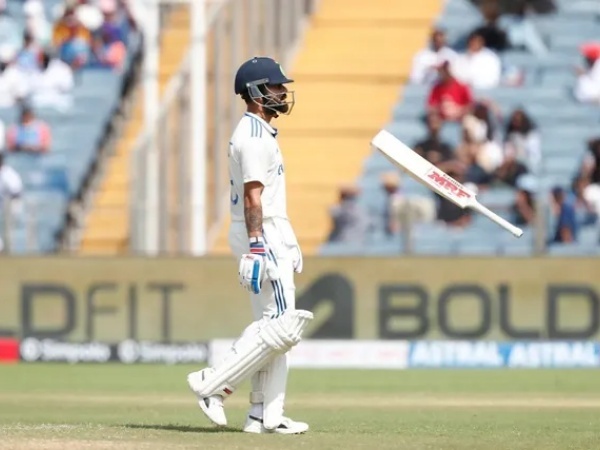views : 736
4 Min Read
Border Gavaskar Trophy: What is the solution for Virat Kohli?
Virat Kohli has always exuded immense confidence in his batting method, seemingly unbothered by what the ball might be doing. This approach has served him exceptionally well over the years. On low-bounce pitches back home, Kohli never hesitated to go onto the back foot, adapting seamlessly. On high-bounce Australian pitches, he turned every pull shot into a spectacle, enhancing the aura of his stroke play. Even on seaming tracks, where others struggled, Kohli continued to drive on the up with elegance. On turning pitches, his flicks against the spin were executed with such precision that they felt like a work of art.
Border Gavaskar Trophy: What is going wrong for Virat Kohli?
This deep trust in his method has defined Kohli's brilliance. In the 2022 T20 World Cup match against Pakistan in Melbourne, where the conditions resembled a Test match, Kohli still dictated terms from a precarious 31 for 4. Without tweaking his approach, he planted his front foot firmly and bent the game to his will, delivering an iconic innings. On Monday in the ongoing Australia vs India Border Gavaskar Trophy 2024-25, however, Virat Kohli faced a different challenge. Against Josh Hazlewood in the fourth over, his usual front-foot dominance faltered. A fairly full delivery rose sharply, surprising Kohli and taking the shoulder of his bat. For a batter who thrives on certainty, this was a moment of reckoning. The question now was whether Kohli would adapt to this new information, altering his approach to counter the conditions. It was a rare moment of vulnerability for someone whose method has been as unwavering as his legacy.
Virat Kohli, determined as ever, became even more “Kohli-like” in the first innings of the India vs Australia 3rd Test match—eager to assert dominance and get onto the front foot. His intent to drive was unmistakable, searching for the slightest opportunity to unleash one of his most iconic shots. In the eighth over, Josh Hazlewood gave him just that, and Kohli pounced. This was a familiar scene—almost like a recurring moment in a suspenseful thriller. It’s happened repeatedly in four out of five innings in this series. Picture a classic horror movie where a character strays from the group, lured toward a mysterious doorway, unable to resist opening it despite every warning. For Kohli, the cover drive has begun to feel like that ominous doorway. Every time he sees an invitation, it’s as though instinct compels him to step through.
Indian fans have grown all too familiar with this narrative. You could almost hear their collective gasps as the ball left Hazlewood’s hand. The tension was palpable as Kohli leaned into the shot. “No, don’t do it,” you could imagine them muttering under their breath. When the outcome was revealed—a feathered edge to the slips—the exasperation erupted. “Why did he do it?” was the inevitable refrain echoing around the ground. What makes it all the more frustrating is that Kohli’s cover drive is one of cricket’s most beautiful sights when it works. But lately, it’s become a double-edged sword—mesmerizing yet treacherous, a temptation he seems unable to resist, even at the cost of his wicket.
Virat Kohli understands that in tough conditions, scoring runs is crucial, as Travis Head has shown throughout this series. Head walked in under pressure in Adelaide and Brisbane, took the attack to the opposition, and turned the tide for Australia. Kohli, too, knows the importance of fighting back. Interestingly, ESPNcricinfo’s ball-by-ball data from the last two years shows Kohli had been dismissed only once by a wide ball from a fast bowler, while averaging 71 and striking at 145. This particular delivery wasn’t in the dreaded corridor of uncertainty—it was wide enough to tempt any batter. However, it’s tempting to imagine Kohli channeling his ODI self in these situations, where his success was built on patience and risk aversion, especially early in his innings. That version of Kohli once replaced one of India’s greatest batters.
In the first innings during the AUS vs IND Perth Test match, Virat Kohli’s approach seemed counterproductive. With pace and bounce being the real threats, he batted a foot out of his crease and pressed forward to a Josh Hazlewood delivery pitched in the middle of the pitch. Perhaps Kohli was trying to replicate methods that worked for him in the past against testing conditions and fast bowlers. However, his half-hearted shot and surprise at the delivery revealed that the gamble hadn’t paid off. In the second innings, where he scored a century, he adjusted his stance slightly, an acknowledgment that his earlier plan had failed.
In Adelaide, the pink ball presented a different challenge, and his first-innings dismissal, where he hesitated between playing or leaving, was uncharacteristic. Kohli is usually decisive, especially when attacking wide deliveries, which he sees as scoring opportunities. However, his dismissal in Brisbane highlighted deeper struggles. With Australia’s tall bowlers extracting extra bounce from the new Kookaburra ball, Kohli seemed unable to adapt. While Steve Smith adjusted his trigger movement, KL Rahul perfected soft hands, and Travis Head freed his arms against the bounce, Kohli appears to lack a contingency plan. His inability to rise above challenging conditions, both at home and in Australia, is concerning. Other batters like Marnus Labuschagne and Nathan McSweeney attempted to leave on length or devised clear strategies to counter good bowling. Kohli, for once, seems to be lagging behind, a rare sight for someone of his stature.
